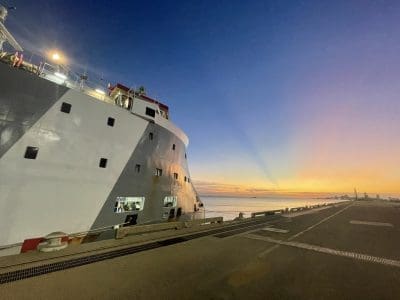Monthly cattle shipments to Indonesia reached a 3.5 year high in December as exporters cleared northern floodplains to deliver 58,250 feeder-weight cattle to Indonesian feedlots to feed for the month-long Ramadan religious festivities which commence in early March.
 The majority of those numbers – 54,973 – were exported from Darwin with 3267 head shipped from Fremantle.
The majority of those numbers – 54,973 – were exported from Darwin with 3267 head shipped from Fremantle.
The end of year rush represented the busiest month for export activity from Darwin since July 2019 when 60,918 head were loaded at the port, and the biggest overall month for cattle exports to Indonesia since June 2020, when 67,062 head were shipped from both Darwin and Townsville.
The Indonesian government has yet to issue new permits for 2024 but more shipments are expected to follow when they are released, with some consignments of heavier cattle likely to be loaded to supplement supplies of cattle on feed for the Lebaran feasting period which begins in early April.
(For more detail on latest market developments see today’s South East Asia Report from Dr Michael Patching)
In total 360,000 cattle were exported from Australia to Indonesia in 2023, up on the 338,454 head shipped to the market in 2022, but still about 17 percent below the rolling five-year average to the market.
Exports to Vietnam for December totalled 11,743 head, bringing total numbers for the year to 126,930 head, about 9pc below the five-year average.
Overall 86,696 cattle were exported from Australia during December, the highest monthly volume since 96,845 head were shipped in June 2021, taking total numbers for the year to 676,260 head, 16 percent below the five-year average.
Israel exports surge in second half of 2023 – but red sea attacks being closely monitored
Lower Australian cattle prices in 2023 have been attributed to a significant increase in cattle shipments from Australia to Israel from August to December last year, with almost 50,000 feeder cattle exported during that five-month period, including 12,428 head from Fremantle in December.
Lower prices for cattle and sheep last year enabled Australian exporters to compete in the market with livestock from Europe.
However shipping activity to the region is now facing potentially significant disruptions caused by Houthi attacks on Red Sea shipping.
Australian Livestock Exporters Council CEO Mark Harvey-Sutton said exporters are closely watching the situation in the region.
“Australian livestock exporters are monitoring the situation very closely and following all Australian Government advice and regulation regarding shipping to the red sea,” he said.
“While there may be some additional cost and complexity to shipping in the area, Australian exporters take very seriously their responsibilities to uphold the highest animal welfare standards and to provide food security to markets in the red sea.
“All Australian livestock consignments have reserve fodder on board as well as Australian Government Accredited veterinarians and stock hands that are responsible for constantly monitoring the welfare of animals on board.”



HAVE YOUR SAY